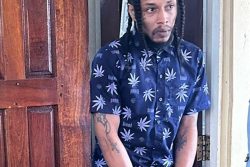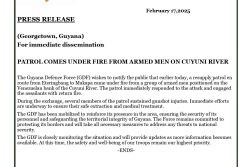Sebai is a riverine community in the Matarkai sub-district of Region One, Barima-Waini. It is situated on the Port Kaituma River, twenty-two miles from the township. The community is home to more than six hundred Amerindians… Arawaks, Caribs and Warraus. They are farmers, mostly, cultivating cash crops including ginger, plantains, beans, and ground provision. Bitter cassava is a ‘big deal’ here. Cassava bread and casareep are the trademarks of the community’s agro-processing prowess. The farmers and agro-processors sell their produce at the Port Kaituma waterfront. Farming apart, fewer numbers of the residents make a living fishing and harvesting timber.
It seems that this has been their way of life from time immemorial. If it is not as though there are signs of a connection between Sebai and urban-type development, there is evidence, much of it, that, like other hinterland communities, Sebai, still lagging some distance behind, is on a protracted mission of playing catch-up.

Port Kaituma’s waterfront market serves as a trading post for buyers and sellers who travel considerable distances to get there. They come from the capital, Georgetown, among other places. The gold mining areas of Matarkai and the farming community of Sebai are well-represented in this mix. The traders who bring their produce here, from Sebai, customarily leave their homes on Wednesdays and Saturdays, between 05:00 hours and 0:600 hrs. They

spend around two and a half hours on the ‘water top’, their boats laden with the produce … vegetables, beans and ginger, which they bring to trade. They arrive at Port Kaituma in a mix of private boats and a community vessel, full of hope. Trading begins almost immediately and ends at around 15:00 hrs. Afterwards they pack the boats with their own purchases, mostly items of food and soft drinks, for the return journey.
A good trading day allows for a feel-good sensation that is tied to the quality of their lives. Their market comprises, mostly, the villagers of Matarkai and the handful of opportunistic traders who find their way there, every two weeks or so, on the ferry coming from Georgetown.
Every day, as the saying goes, may be fishing day; catching is another matter. On the not-so-good or bad days the visitors from Sebai must leave the unsold perishable produce which they brought with them with the shopkeepers at Port Kaituma. What is left, otherwise, they must take back with them. It is an arrangement that is fraught with risk, not the best ‘business model’ in the world, but it is what they have. Perhaps more to the point, it is a circumstance that exposes the limitations in the way of life which Amerindian communities in Guyana have suffered from time immemorial, the ‘noises’ of urban politicians about hinterland development, notwithstanding.
There are Amerindians in their respective communities who are passionate about the development of their own people but who have learnt to live with the limitations of the hinterland… like Sherlon Rodrigues, a Dr Cheddi Jagan Dental School-trained dental assistant. Rodrigues is thirty-seven and has leadership ambitions. He is a candidate at the forthcoming elections to choose a new Toshao for the community. He is, he says, concerned about the risk-laden trading arrangements which the farmers and agro-processors of Sebai must endure.
Raymond James, the current Toshao, says that it used to be different. That was when gold mining at Port Kaituma was in its heyday. The miners, he says, were the farmers’ and agro processors’ main market. When the Stabroek Business visited Port Kaituma in 2017 the Sebai traders had told us the same story about the better times that were linked to the role which gold mining at Port Kaituma had played in the local economy.
These days, trading relies almost exclusively on the residents of Matarkai and the traders who come from Georgetown. After several decades of central government pronouncements about Amerindian development, key elements of their existence still remain fraught with risk and uncertainty.
The unequal nature in the development of the various communities scattered across the country is reflected nowhere more than in the challenges limitations facing our Amerindian communities. A week ago, bags of ginger, a commodity for which demand in coastal communities has skyrocketed with the onset of the coronavirus pandemic, were lying idle at the Port Kaituma waterfront market. The reason? The fact that the river transport necessary to move the commodity to Georgetown where it can be sold at a competitive price only arrives there once weekly. It is the kind of logistical failure which the authorities never cease to bemoan but which they have failed to remedy over the years.
Toshao James, who also serves as the Captain of the community boat, says he is hoping for government intervention to help create reliable linkages between the farmers at Sebai and the lucrative coastal market. There are times, James says, when the trading at Port Kaituma is so ‘slow,’ that the farmers from Sebai are hard-pressed to raise the $2,000 return fare home. Out of a sense of duty, he says, he must sometimes meet the cost of fuelling the vessel to move the hard-pressed farmers on the return journey, out of his own pocket,
Rodrigues is hopeful of being elected Toshao. He is already a community public figure in his own right and is a one-time chairman of the Matarkai Sports Council and currently serves as the Council’s Public Relations Officer. He too attests to the fact that there are occasions on which the Sebai farmers return from the trading sorties to Port Kaituma with a great deal of their produce unsold. He floats the idea of a value-added initiative that might increase the demand for processed products. In the absence of machinery, equipment, training and market linkages, however, the idea is unlikely to go very far.
Sebai has been in receipt of a $15 million COVID-19 cash grant from the state. Part of it is being spent to complete a community computer hub. That will afford one of the country’s many remote communities some measure of access to information technology training. Another portion of the grant is being used to repair a re-sawing machine used to properly prepare wood for some production purposes. It is a facility that will support the area’s lumber industry significantly. The industry, it is felt, can then be positioned to meet the lumber and furniture needs of schools in Sebai and even Port Kaituma.
Yet another portion of the $15 million grant is to be spent on effecting repairs to an out-of-service John Deere tractor and trailer that has been out of service for many years. Once it is ‘up and running,’ It is hoped that it can be used to assist in the movement of logs from the backdam and into the community. What is left will be used to purchase a generator to power the renovated re-sawing machine.
Rodrigues says that domestic violence, child abuse, and teenage pregnancy are challenges facing the Sebai community. There is, he says, need for a Welfare Officer in the community. There is a Nursery School and a Primary School at Sebai. Secondary Education is offered at Port Kaituma. Cricket and soccer are popular at Sebai but the current lockdown has affected recreation. Toshao James says that there are no active COVID-19 cases in the community.








